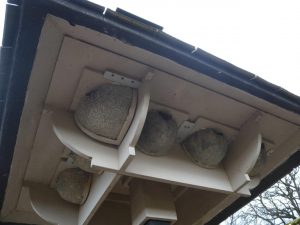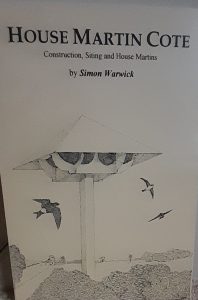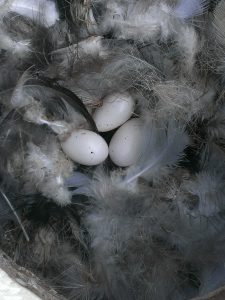Artificial nest sites, which of course includes nestboxes, have become a feature of British gardens, woodlands and nature reserves in the last 40 to 50 years, even diversifying into special “walls” for Sand Martins, concrete riverbank tunnels for Kingfishers and even Osprey nest platforms.



Centuries earlier, the First Nation peoples of North America and Canada discovered that purple martins would nest in suitably positioned, dried gourds – this habit has been adapted to the modern day, with the construction of palatial “martin condominiums”, housing substantial colonies of this species.
On a visit to Canada in 1992, we first saw the amazing design of purple martin cotes and how successful they were at attracting the target species for breeding (also quite popular with Tree Martins). This sowed the seed of an idea in Simon’s mind for attracting house martins to breed with us.
Swallows used our garage readily, but the eaves of our Georgian farmhouse were not extensive enough to attractive house martins and with the demolition of a popular nest site in our village several years earlier, we were keen to attract them back.
Coincidentally, in a neighbouring village, a study was being undertaken of a small house martin colony, using artificial nests fixed under the eaves of two semi-detached farm cottages. We made a template from one of these home-made artificial and very heavy boxes, which Simon cleverly modified – instead of using just concrete he added gardener’s vermiculite to the mix, which gave the required durability but also made the boxes much lighter in weight.
The boxes were also specifically designed to be removable rather than fixed onto a structure, thus the chicks could be ringed from inside the artificial nest cup (I am a licensed British Trust for Ornithology (BTO) bird ringer), which also allowed a peek into the otherwise unseen lives of these trans-Saharan migrants. Few house martin chicks are ringed in the UK, because it is impossible to access their mud nests without causing damage, which is forbidden under the rules of the BTO Ringing Scheme.
The next design phase was more of a challenge – how to position the artificial nestboxes to create our own colony? Again, the magnificent structures we saw in Canada were inspirational and our stand-alone house martin cote, reminiscent of a small Japanese pagoda, was constructed! Four sides, with two boxes fitted on each side and three corner boxes, under a deep, wooden shingle roof at the top of a 5 metre timber post became Mark I, which served its purpose well for over 20 years.
Each artificial nestbox is numbered (1 to 12) and by catching the adults using a hand net, it is possible to assign each adult to a nestbox. Most will use the same box for the second brood, but on occasion others prefer a change of outlook! Some adults have even changed partner between broods, but this is relatively rare.
Several years ago, Mark II was created, where the whole roof structure, with nestboxes, can be lowered and raised via a metal cable which runs down the centre of a new, hollow metal support pole and is attached to a small winch (similar to those used on yachts).
The cote is always a talking point when friends visit and on a summer evening, whilst sitting on our terrace, watching the activities of the birds feeding frantically begging chicks or listening to a ‘singing’ male hidden inside a nestbox, has now become part of our lives.
Look out for part 2 of this article to follow in the next newsletter where Jill will be providing data from their 30-year study and ringing of their house martin cote colony.
Written by Jill Warwick, North Yorkshire

